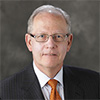Download PDF

By David W. Parke II, MD, Executive Vice President/CEO
As I write this in mid-December, we are actively embroiled in legislation to “fix” the Sustainable Growth Rate (SGR). By the time you read this, we will likely still be dealing with the SGR. For most of us, the incessant calls to “Contact your member of Congress now to fix the SGR!” threaten to induce a sort of cerebral repetitive stress injury. However, in all honesty, there is little we can do in the advocacy arena that has greater import!
As physicians, we operate in a monopsony. For those who didn’t take Econ 1, a “monopsony” exists when a market is controlled by only one—or one very dominant—buyer. We all know that, in general, commercial payers peg their payments against trends in Medicare payments. Thus, the trickle-down impact of Medicare rates affect nearly every service for which physicians seek third-party reimbursement.
The SGR is widely agreed upon by economists, policymakers, Congress, and physicians to be a deeply flawed system that should be replaced. Over the past dozen years, the average annual Medicare physician payment update has been just 0.29 percent. The average annual rate of “medical inflation” (cost of running an office) has been closer to 3 percent—rising about 25 percent over 12 years. This has resulted in a net average payment rate to physicians plummeting 17 percent.
The “bicameral, bipartisan” proposal put forth by the Senate Finance Committee and House Ways and Means Committee on Dec. 5 called for a freeze on Medicare payments for 10 years. It contained language that incentivized a move away from fee-for-service and into “alternative payment models.” Suffice it to say that there are plenty of issues with the details of these models and their accessibility to ophthalmologists. Your Academy joined many other surgical societies in opposing these proposals. Yes, I know that it might cost us “a seat at the negotiating table”—but how could we support anything that would pay our members the same in 2023 as in 2013?
The December issue of Ophthalmology includes an article entitled “Cataract Surgery Cost Utility Revisited in 2012.” It concluded that cataract surgery was 85 percent less expensive than in 1985; the 2012 inflation-adjusted physician fee was 10 percent of what it was in 1985; and cataract surgery’s 13-year financial return on investment to society was 4,567 percent!
In a society moving to “value-based payments,” many ophthalmology services have extraordinary value—both quantitatively and qualitatively. But changes in Medicare physician payment have a particularly direct impact on ophthalmology, which has a higher percentage of Medicare-age patients than any other other specialty except for geriatrics. And if inadequate payment proves economically untenable and creates an access problem for patients, no one wins. Carefully balancing the impact on cost, quality, and access requires the use of a keen blade, not the blunt political cudgel of “no increases for 10 years.”
For this is about politics as much as about policy and common sense. Your Academy will continue to advocate for ophthalmologists and our patients as strongly as we can with the resources available to us. One of the most powerful resources is your voice—and your patients’ voices. I’ll say it again—for the umpteenth time. Contact your members of Congress! For many years we’ve called for an SGR fix—but we must support only the right fix, for the sake of our patients and our future.